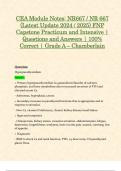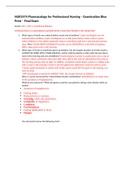CEA Module Notes: NR667 / NR 667
(Latest Update ) FNP
Capstone Practicum and Intensive |
Questions and Answers | 100%
Correct | Grade A – Chamberlain
Question:
Hyperparathyroidism
Answer:
> Primary hyperparathyroidism is a generalized disorder of calcium,
phosphate, and bone metabolism due to increased secretion of PTH and
elevated serum Ca.
- Adenomas, hyperplasia, cancer.
> Secondary increases in parathyroid hormone that is appropriate and in
response to stimulus.
- Now Ca, vitamin D deficiency, chronic kidney disease/renal failure.
> Signs and symptoms
- Osteoporosis, kidney stones, excessive urination, abdominal pain, fatigue,
depression, forgetfulness, weakness, bone or joint pain, nausea, vomiting, loss
of appetite.
> Diagnostic
- BMP to check Ca and renal function, PTH, 24-hour urine, US parathyroid
gland, Dexa.
,> Treatment
- Vitamin D replacement if needed, surgery only if meets criteria, medication
management, biphosphates.
Question:
Hypothyroidism
Answer:
> Low calcium and deficient or absent parathyroid hormone
> Causes
- Anterior neck surgery or radiation
- Autoimmune or heredity
- Low PTH, hypo parathyroid
> Signs and symptoms
- Confusion, memory loss, tetany/muscle spasms, weakness, paresthesia's,
arrhythmias, SOB, Chvostek's and trousseau sign.
> Treatment
> Lifelong Ca and vitamin D.
Question:
Pituitary Adenoma
Answer:
> Benign tumors, most are In the anterior lobe
>Some pituitary adenomas secrete one or more hormones in excess
,> even when they are small, pituitary tumors can cause hormonal imbalances
that affect body functions
> types
- microadenomas
- macroadenomas
- prolactinomas
> signs and symptoms
- headache, vision problems, weight gain, menstrual irregularities,
galactorrhea, ED, temperature intolerance, change in bone structure.
> Treatment
- Prolactinoma-dopamine agonists (cabergoline, bromocriine), surgical
consult.
Question:
Diabetes insipidus
Answer:
> Inadequate arginine vasopressin secretion or inadequate renal response
> Results in hypotonic polyuria with polydipsia
> Can be heredity or acquired
> Central
- Pituitary not releasing enough ADH
- Primarily by lesions in the neurophydrophysis or hypothalamic region
- Deficient release of AVP
- Trauma, surgery, infection
, > Nephrogenic
- Renal resistance to AVP
- Drug induced
- Hypercalcemia/hyperkalemia
- Infiltrating lesions
> Signs and symptoms
- Excessive thirst and urination
> Diagnostic
- 24-hour testing
- Urine osmolarity
- Creatinine
> Treatment
- DDAVP oral or sublingual 100-200 mg 1-3 times daily
- Nephrogenic: eliminate cause, reduce sodium/protein, thiazide diuretic,
and/or amiloride-helps concentrate urine.
Question:
SIADH
Answer:
> Overproduction of antidiuretic hormone
- Impairs water excretion
- If water intake exceeds water output, hyponatremia ensues
> Causes
- Malignancy (small cell lung cancer, pancreatic, colon, lymphoma, etc).





